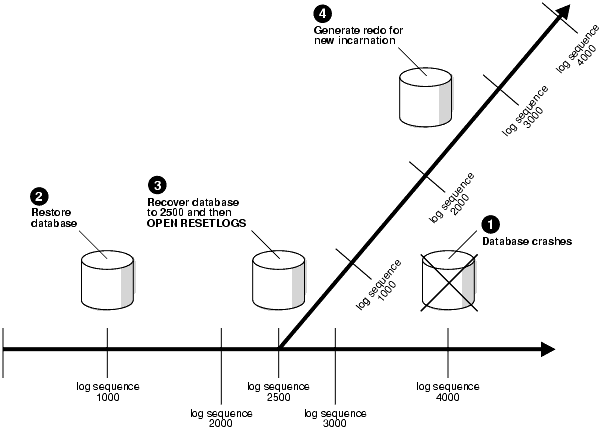| Oracle® Database Backup and Recovery Advanced User's Guide 10g Release 2 (10.2) Part Number B14191-02 |
|
|
View PDF |
| Oracle® Database Backup and Recovery Advanced User's Guide 10g Release 2 (10.2) Part Number B14191-02 |
|
|
View PDF |
Whenever you perform incomplete recovery or recovery with a backup control file, you must reset the online logs when you open the database. The new version of the reset database is called a new incarnation.
This section contains the following topics:
The RESETLOGS option is always required after incomplete media recovery or recovery using a backup control file. Resetting the redo log does the following:
Archives the current online redo logs (if they are accessible) and then erases the contents of the online redo logs and resets the log sequence number to 1. For example, if the current online redo logs are sequence 1000 and 1001 when you open RESETLOGS, then the database archives logs 1000 and 1001 and then resets the online logs to sequence 1 and 2.
Creates the online redo log files if they do not currently exist.
Reinitializes the control file metadata about online redo logs and redo threads.
Updates all current datafiles and online redo logs and all subsequent archived redo logs with a new RESETLOGS SCN and time stamp.
Because the database will not apply an archived log to a datafile unless the RESETLOGS SCN and time stamps match, the RESETLOGS prevents you from corrupting datafiles with archived logs that are not from direct parent incarnations of the current incarnation.
In prior releases, it was recommended that you back up the database immediately after the RESETLOGS. Because you can now easily recover a pre-RESETLOGS backup like any other backup, making a new database backup is optional. In order to perform recovery through resetlogs you must have all archived logs generated since the last backup and at least one control file (current, backup, or created).
Figure 18-1 shows the case of a database that can only be recovered to log sequence 2500 because an archived redo log is missing. When the online redo log is at sequence 4000, the database crashes. You restore the sequence 1000 backup and prepare for complete recovery. Unfortunately, one of your archived logs is corrupted. The log before the missing log contains sequence 2500, so you recover to this log sequence and open RESETLOGS. As part of the RESETLOGS, the database archives the current online logs (sequence 4000 and 4001) and resets the log sequence to 1.
You generate changes in the new incarnation of the database, eventually reaching log sequence 4000. The changes between sequence 2500 and sequence 4000 for the new incarnation of the database are different from the changes between sequence 2500 and sequence 4000 for the old incarnation. You cannot apply logs generated after 2500 in the old incarnation to the new incarnation, but you can apply the logs generated before sequence 2500 in the old incarnation to the new incarnation. The logs from after sequence 2500 are said to be orphaned in the new incarnation because they are unusable for recovery in that incarnation.
Figure 18-1 Creating a New Database Incarnation

To preserve the log sequence number when opening a database after media recovery, execute either of the following statements:
ALTER DATABASE OPEN NORESETLOGS; ALTER DATABASE OPEN;
To reset the log sequence number when opening a database after recovery and thereby create a new incarnation of the database, execute the following statement:
ALTER DATABASE OPEN RESETLOGS;
If you open with the RESETLOGS option, the database returns different messages depending on whether recovery was complete or incomplete. If the recovery was complete, then the following message appears in the alert_SID.log file:
RESETLOGS after complete recovery through change scn
If the recovery was incomplete, then this message is reported in the alert_SID.log file, where scn refers to the end point of incomplete recovery:
RESETLOGS after incomplete recovery UNTIL CHANGE scn
If you attempt to OPEN RESETLOGS when you should not, or if you neglect to reset the log when you should, then the database returns an error and does not open the database. Correct the problem and try again.
See Also:
"About User-Managed Media Recovery Problems" for descriptions of situations that can causeALTER DATABASE OPEN RESETLOGS to failAfter opening the database with the RESETLOGS option, check the alert_SID.log to see whether the database detected inconsistencies between the data dictionary and the control file, for example, a datafile that the data dictionary includes but which is not listed in the new control file. The following table describes two possible scenarios.
| Control File | Data Dictionary | Result |
|---|---|---|
| Datafile is listed | Datafile is not listed | References to the unlisted datafile are removed from the control file. A message in the alert log indicates what was found. |
| Datafile is not listed | Datafile is listed | The database creates a placeholder entry in the control file under MISSINGnnnnn (where nnnnn is the file number in decimal). MISSINGnnnnn is flagged in the control file as offline and requiring media recovery. You can make the datafile corresponding to MISSINGnnnnn accessible by using ALTER DATABASE RENAME FILE for MISSINGnnnnn so that it points to the datafile. If you do not have a backup of this datafile, then drop the tablespace. |